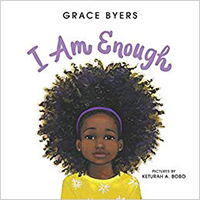I Am Enough by G. Byers
DOI:
https://doi.org/10.20361/dr29442Abstract
Byers, Grace. I Am Enough. Illustrated by Keturah A. Bobo, Balzer + Bray-Harper Collins, 2018
I Am Enough by Grace Byers is an uplifting and motivating book about female empowerment and respect for diversity. The consistent message through this book is one of self-worth and embracing differences. Byers emphasizes that regardless of one’s looks, abilities, or beliefs, every child is unique, able, and worthy of respect. Her message encourages children to recognize diversity and show respect and kindness to others. She poetically portrays messages of empowerment through the use of simple simile and rhyme. For example, she writes “Like the sun, I’m here to shine” and later: “...that does not dictate our worth, we both have places here on Earth.” Her use of rhyme allows the book to read smoothly and rhythmically, and simile encourages the reader to think carefully about the message on each page. Many of the messages are simple and clear, while others may require more careful thought and discussion to build meaning from the message. The front cover of her book shows the face of a young girl of colour, which paired with the bold title "I Am Enough" sets the tone of diversity, acceptance, and strength, seen throughout the book.
Byers’ messages of empowerment are complemented and supported by Keturah Bobo’s illustrations. Bobo’s illustrations artistically and realistically depict children from a variety of ethnic backgrounds and abilities. Great thought and detail has been put into the characters in the illustrations, authentically depicting girls from a variety of different races and cultures. This book could be a mirror for children from a variety of backgrounds, allowing them to see themselves in this book. Bobo’s illustrations add a great deal of meaning to this story, as the theme of diversity is not explicitly stated in the text until the end of the book, but is clearly portrayed in the images throughout the pages. The children featured in this story are elementary aged, matching the intended audience. The characters in the foreground are complemented by background images of simple crayon sketches. The use of crayon further appeals to the intended audience of young children.
This is Grace Byers’ first children's book. She grew up in a diverse background of a multiracial family, as well as the child of deaf parents. She wrote this book to empower young girls against bullying and promote an understanding of diversity and the importance of showing kindness to others. Her intended audience is elementary aged children (particularly girls, as females are the focus in the illustrations), however this book is a great read for everyone. The mantra “I am enough” has the potential to resonate with individuals of any age or background, so the message portrayed can appeal to a variety of readers. This book would be an excellent addition to school and classroom libraries.
Highly Recommended: 4 out of 4 stars
Reviewer: Bethany Semotiuk
Bethany Semotiuk is an elementary teacher and open studies student at the University of Alberta. She has a special interest in early literacy development and plans to pursue graduate studies focused in children’s language and literacy. She enjoys reading children’s literature in her classroom as well as for personal pleasure.

Published
How to Cite
Issue
Section
License
Authors who publish with this journal agree to the following terms:
- Authors retain copyright and grant the journal right of first publication with the work simultaneously licensed under a Creative Commons Attribution License that allows others to share the work with an acknowledgement of the work's authorship and initial publication in this journal.
- Authors are able to enter into separate, additional contractual arrangements for the non-exclusive distribution of the journal's published version of the work (e.g., post it to an institutional repository or publish it in a book), with an acknowledgement of its initial publication in this journal.
- Authors are permitted and encouraged to post their work online (e.g., in institutional repositories or on their website) prior to and during the submission process, as it can lead to productive exchanges, as well as earlier and greater citation of published work (See The Effect of Open Access).






